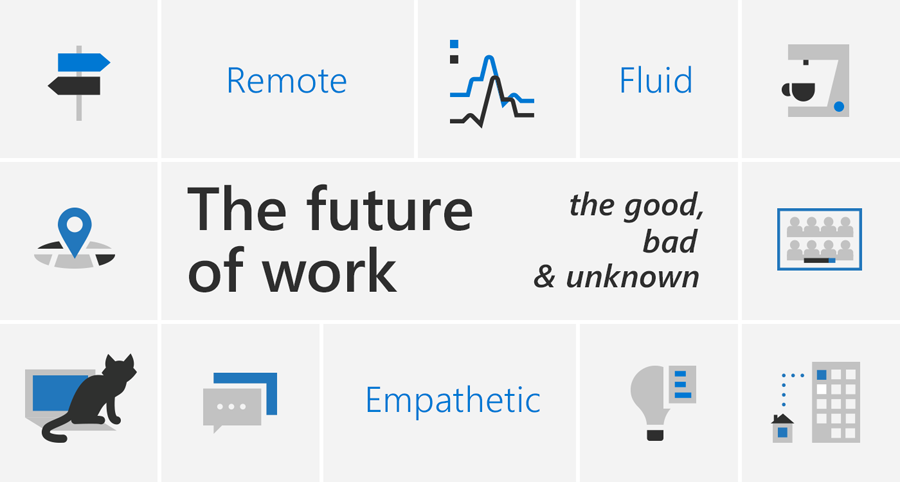Microsoft: Working remotely and returning to in-person work can be just as difficult

In the last four months, work has changed drastically, but will these changes persist into the future?
To answer those questions, Microsoft developed the second Work Trend Index, combining insights from three sources: trends behind how customers use its tools; findings from a Harris Poll survey of more than 2,000 remote workers in six countries; and conclusions from more than 30 research projects across Microsoft that seek to understand the experience of remote workers today via surveys, interviews, diary studies, focus groups, and studies of the human brain.
Microsoft’s goal was to uncover both “positive and challenging aspects” of remote work to accelerate product development in the right areas, anticipate how work will change in the future, and help customers thrive in this new world of work.
Key findings include:
Remote collaboration is harder, but the transition back to in-person work might be just as tough
In one of Microsoft’s studies, researchers asked 13 teams, consisting of two people each, to complete similar tasks together — once in-person and once remotely, while changes in brainwaves were monitored using an EEG device.
Brainwave patterns associated with stress and overwork were much higher when collaborating remotely than in-person. But they found something unexpected as well: If the pair first worked together remotely, their brainwaves suggested it was more difficult for them to work together in-person afterwards.
This study provided two conclusions — in a world that’s moving to more remote work, people find remote collaboration more mentally challenging. But also, as people return to more frequent in-person work as the pandemic eases it may feel more difficult than it did before COVID-19, the company confirmed.
Video meetings lead to fatigue
A second study found that brainwave markers associated with overwork and stress are significantly higher in video meetings than non-meeting work like writing emails.
Further, due to high levels of sustained concentration fatigue begins to set in 30-40 minutes into a meeting. Looking at days filled with video meetings, stress begins to set in at about two hours into the day, the study showed.
“The research suggests several factors lead to this sense of meeting fatigue: having to focus continuously on the screen to extract relevant information and stay engaged; reduced non-verbal cues that help you read the room or know whose turn it is to talk; and screen sharing with very little view of the people you are interacting with,” the company said.
To help address these challenges through its technology, Microsoft released a series of updates to Teams designed to help create a more human connection with people users are working with and to reduce meeting fatigue — Together mode and Dynamic view.
The pandemic will have a lasting impact on work
More than half of the parents surveyed (54%) said it has been difficult balancing household demands while working from home.
This burden was felt most heavily by millennials as well as new entrants to the workforce, Generation Z. This may be because this group is more likely tasked with caring for younger children or sharing workspaces with roommates while managing a full-time job.
“While balancing childcare with remote work may be temporary, it may change how we feel about our co-workers long-term. 62% of people surveyed said they feel more empathetic toward their colleagues now that they have a better view of life at home. This feeling was especially pronounced in China and Mexico where 91% and 65% of those surveyed felt more empathetic, respectively,” the Microsoft-commissioned study reveled.
In some cases, the move to more remote work is also making work more inclusive. More than half (52%) of the people we surveyed feel more valued or included as a remote contributor in meetings because everyone is now in the same virtual room.
This feeling was more strongly held by people in China (65%) and Germany (57%), the study showed.
The 9-to-5 workday may be fading away
In Teams, people are working more frequently in the morning and evening hours, but also on the weekends. Teams chats outside of the typical workday, from 8-9 a.m. and 6-8 p.m., have increased more than any other time during the day (between 15% and 23%).
Weekend work is spiking as well – Teams chats on Saturday and Sunday have increased more than 200%, the software company confirmed.
Physical offices will not disappear in the future of work
Microsoft’s research indicates that work will likely be a fluid mix of in-person and remote collaboration. 82% of managers surveyed expect to have more flexible work from home policies post-pandemic. Additionally, 71% of the employees and managers reported a desire to continue working from home at least part-time.
“Still, our research uncovered several pain points associated with working from home. Nearly 60% of people we surveyed feel less connected to their colleagues since working remotely more often. In China, this number spiked to 70%,” the company said.
In addition, only 35% of respondents in one study have a dedicated home office. And only 5% of the people surveyed in our Harris Poll live alone.
“So, it’s no surprise that distractions, connection issues, and lack of ergonomic work environments were noted throughout our research as some of the top pain points of remote work,” Microsoft said.
“This indicates that while the future of work will be more remote than it’s ever been before, the physical office space – which brings benefits like connected, ergonomic workspaces and opportunities for social connecting and team bonding – will likely remain a core part of the future of work,” the company said.














